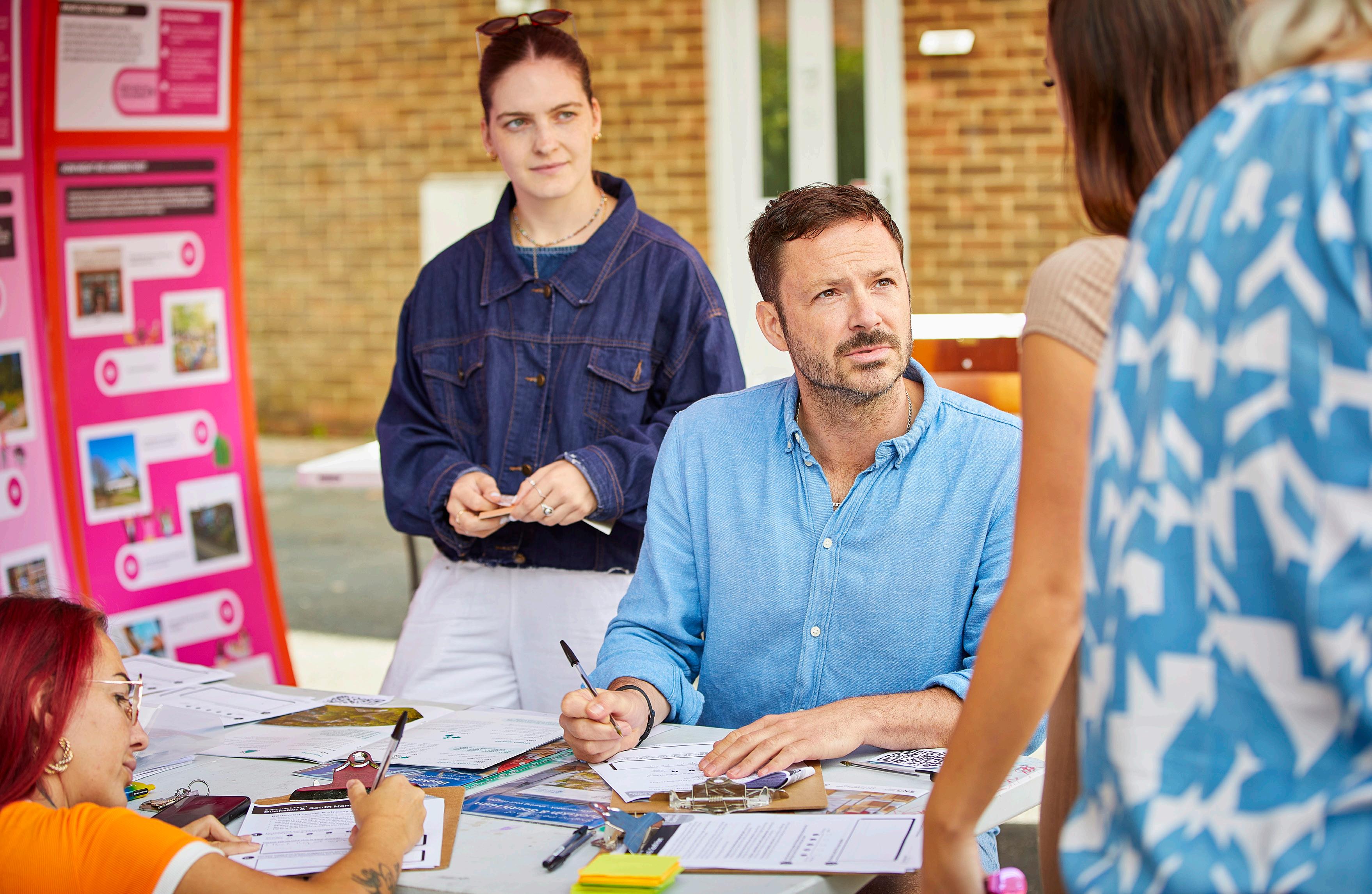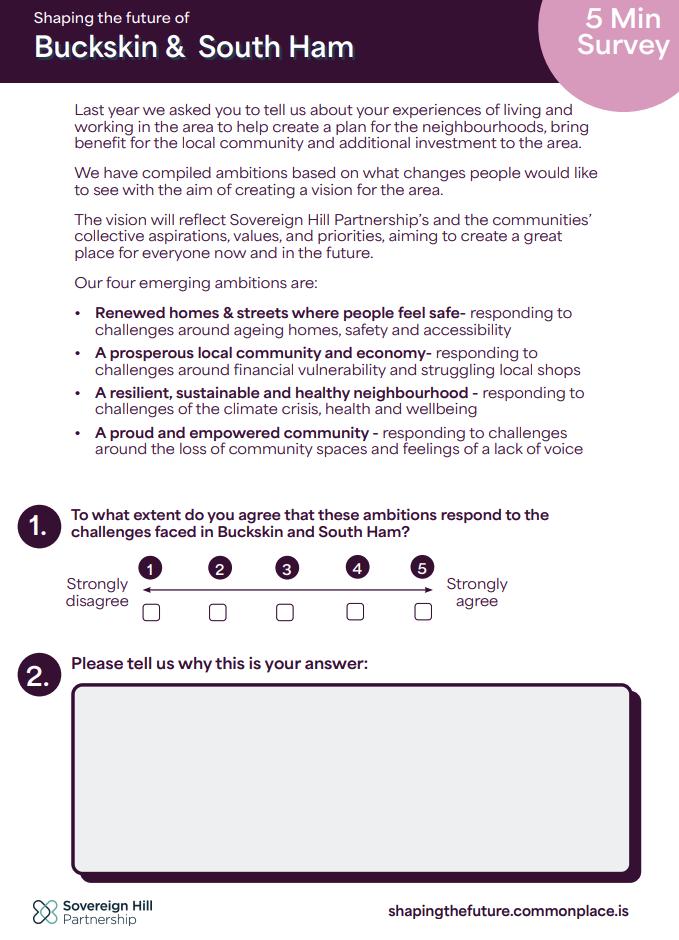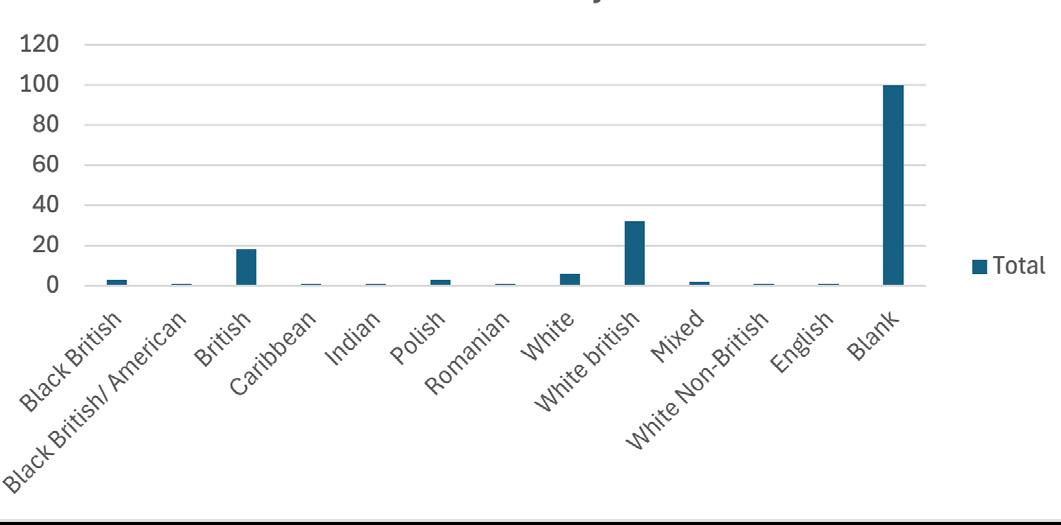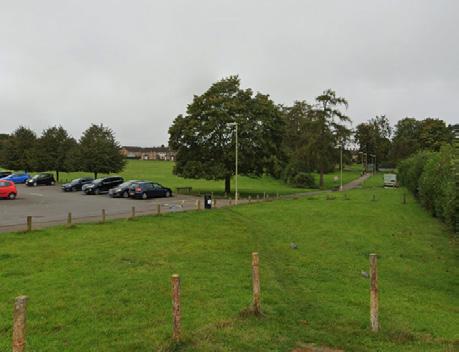
Stage 1: Engagement Summary Report

Section 1
This part of the report summarises the process undertaken to gather insights from the community. It outlines all of the events taken place as well as data around demographics.


Stage 1: Engagement Summary Report

This part of the report summarises the process undertaken to gather insights from the community. It outlines all of the events taken place as well as data around demographics.
This report summarises resident engagement over summer 2024 as part of a wider consultation process to develop a plan for the future of Buckskin and South Ham. This report is written by Something Collective, an engagement consultancy, on behalf of the Sovereign Hill partnership.

Sovereign Network Group (SNG), a significant landlord in the South Ham and Buckskin area, are looking to making improvements locally. They have partnered with house builder The Hill Group, to explore the options for improvements and make a plan for the
To understand people’s experience of where they live, the challenges they face and their ambitions for change, SHP is undergoing long term consultation with residents in the area. Commencing in 2023, consultation has involved public surveys, an ongoing digital and print communications campaign, events and targeted engagement with specific
The specific area under consideration spans from South Ham in the east to Buckskin in the west, captured in the following map: Summer 24 engagement:
Summer engagement with residents in the Buckskin and South Ham area builds upon previous engagement in autumn 2023. Autumn 2023 focused on creating baseline data that captured individual's experience of their homes and neighbourhoods as they are today. Summer 2024 intended to develop a set of ideas and design principles that reflect the community's ambitions for their future homes and neighbourhoods.
Engagement key aims:
• Identifying diverse voices.
• Establish a core group of residents to work in-depth with
• Understanding people’s lived experience in relation to specific masterplan themes/topics and how things can be improved.
• Establishing the overarching vision.
• Testing principles, themes and topics that can inform strategic options development.
Engagement mechanisms:
Engagement used three key channels to ascertain both breadth and depth to research. A twin-programme of 'in-depth' working was established through a 'Young Design Academy' targeted at people aged 16-24 and a 'Community Co-Design Associates' programme targeted at residents over 24. Both programmes involved training and re-numeration allowing local residents to engage and provide comprehensive feedback on their lived experience and an emerging vision for the area.
To ensure engagement was as wide as possible these programmes were complimented by a public engagement programme including walkabouts, pop-ups and community exhibition event. This allowed for a breadth of feedback captured in a survey



Engagement Summary Report
This report brings together a period of summer engagement that has been conducted through different work-streams. The report has been written to summarise key findings from the CDA and YDA group, as well as the general public.

We held a series of training sessions and workshops with a local residents to introduce them to topics around UK planning, principles of good design and masterplanning. The workshops were designed to explore the emerging ambitions and other design principles like green space, connectivity and housing to gather insights into improving the area.
We worked with 9 local people who were recruited through a local print and digital campaign, and were paid for their time.
Why we did it:
To provide the group with an opportunity to gain skills and training in urban design.

We held a design sprint over four sessions to introduce urban design and research. A series of design challenges were lead by both SoCo and Turner Works, leading young people to propose interventions that respond to local challenges and create positive change.
We worked with 7 young people aged between 16 and 24 years old. They were recruited through a local print and digital campaign, specifically promoted through local schools and colleges.
To provide young people with an opportunity to up-skill in urban design, develop skills needed for a career in the industry, whilst using lived experience to both analyse and design improvements for their neighbourhoods.

The summer social events were held at the start and end of the summer to engage the public in discussions around the emerging ambitions, and to encourage them to get involved by filling out the survey.
Start of Summer Social:
Location: Russell Howard Park
Date: 27th July 2024
No. of participants: 100

End of Summer Social:
Location: Burnaby Shops
Date: 29th August 2024
No. of participants: 100

Throughout this engagement period we spoke to different people within the area. Across all of the engagement events and online survey, we have identified different groups of people we have spoken to.

Gender Age

Ethnicity

How long residents have lived in the area

Tenure

Here we have identified the different areas of Buckskin & South Ham that we have reached through our engagement. This has been categorised based on the LSOA (Lower Sayer Output Area).
Basingstoke and Deane 013A
Basingstoke and Deane 013D
Basingstoke and Deane 013B
Basingstoke and Deane 014D
Basingstoke and Deane 014B
and Deane 014C
This section of the report summarises the response to the ambitions across both the CDA, YDA and general public via survey.
Here is a summary of the overall feedback on the ambitions from each group that identifies areas of support and potential challenges.
Support:
The ambitions were generally supported by the group; however there are varying opinions on how these should be achieved.
The ambitions were supported by the YDA, with an indication that wide-scale change will be supported if it brings more opportunities and people to the area.
There was general support of ambitions but without specifics of where and what due to high-level nature of survey.
Challenges:
There is a stronger focus on immediate priorities and potential meanwhile projects for improvements, rather than wide-scale long term change.
There was a desire to understand more about the specifics of each ambition, and what this would mean for the community.
There were low levels of acknowledgement of project and take-up of opportunities to get involved/ feedback. 170 responses in an area of over 4000 households.
Both in discussions with the CDA’s and the YDA, it is highlighted that the ambitions do not explicitly support the recognition, celebration or strengthening of local culture and identity. Participants felt this was a missing element with an over-emphasis on physical design interventions.
Public art, recognition of diversity and different identities and cultural programming are all seen as important elements of improving the neighbourhoods and empowering communities.
It is clear that there is a general support for change; however the scale of this change has not yet been identified and therefore there will need to be specific conversations of what / how the ambitions could be applied spatially. This is something that will need to be explored during future rounds of engagement.

Renewed homes & streets where people feel safe- responding to challenges around ageing homes, safety and accessibility.
CDA’s:
The group felt that creating safer streets, particularly at night time was a priority for improving the area.
They agreed that by improving the conditions of homes people would take more pride in where they live, and that changing attitudes in the area could help tackle some of the social issues they are currently facing.
YDA’s: General Public:
The general consensus was that this ambition would improve the safety of the area, making people feel more confident when travelling around (particularly in Buckskin), and as a result feel more inspired. There was support for more quality housing locally including new types of housing such as apartment blocks.
However, there were fears that in achieving this ambition memories would be lost, and they raised the point that some people like the area how it is.
People have acknowledged the need for better homes due to aging and run down homes. The general consensus amongst residents is that new homes would help create neighbourhoods that people feel proud of, and would improve the overall health and well-being of the area.
Many people felt it was vital to improve the conditions of streets and pathways around homes, and increase parking in the area to improve accessibility.
A spatial map to highlight some of the key points of feedback recieved in relation to Ambition 1.
Young people prefer taking this route, despite it taking longer, because it feels nicer and safer.

Disused garages create opportunities for antisocial behaviour and dark corners, which obstruct lines of sight.
The Burnaby shops area is really confusing to navigate and feel unsafe due to its menacing and unwelcome presence.

Reduced parking around homes creates obstructions to pathways and does not support accessibility needs.

The paths and walkways are really overgrown and uneven.

It feels unsafe to walk around this part of Buckskin at night because there is a lack of lighting, few people around.
*Diagram correct to summer 2024


Signage and way-finding around the area is confusing or non-existent.
Alleyways feel dark and unsafe due to lack of lighting, tall fences and little activity and surveillance.

Pavement surfaces are uneven, making it difficult for wheelchair and pushchair users.
There are no clear routes between Western Way and Pinkerton Road.
A prosperous local community and economy - responding to challenges around financial vulnerability and struggling local shops.
CDA’s:
The group analysed this ambition from a social perspective. They felt it was vital that a community hub was recreated to replace the loss of the Westside Community Centre, and that it might be nice to have multiple centres.
There is a general desire for quick fixes to build community spirit and a willingness to get involved in whatever that may be. There was less support for bringing industry / employment into the neighbourhood, preferring a separation between home and work.
YDA’s: General Public:
The group felt that creating more opportunities for young people, specifically 16-24 year olds was important. They thought that ambitions for the future are hindered by a lack of infrastructure and formal support in how skills can be developed / employment found.
The group felt that a prosperous community could be achieved through creating more activities, job opportunities, community centres and improving connections and housing close to Basingstoke town centre.
This ambition was generally supported with a lot of people prioritising the need for better support for new businesses, more affordable opportunities for young people and more community spaces to hold community events.
It was also evident that people enjoyed the community events taking place over the summer, and wanted to ensure that more of these events took place in the future, with better advertisement.
A spatial map to highlight some of the key points of feedback recieved in relation to Ambition 2.
The shops in Burnaby feel run-down and unwelcoming.
Parents pass through this area on the school run but there is nowhere to stop and socialise.


The Westside Community Centre was a huge loss to the community. The library was loved, and now there is nothing for the community in that area.
People travel outside of the area to socialise / go shopping and find places to eat.

There is little variety of shops in the Buckskin area, and not really a reason for people to visit.
*Diagram correct to summer 2024
The closure and lack of shops / amenities in these spaces make it feel derelict and unsafe, particularly at night time.
The bus system is unreliable and there are not enough bus stops around the area.

The Kings Road shops are run down and outdated. It has become a hotspot for antisocial behaviour, particularly in the evenings.
There is not enough parking outside of shop fronts.
There are very few places for young people - few shops and places to eat or drink.
A resilient, sustainable and healthy neighbourhood - responding to challenges of the climate crisis, health and well-being.
CDA’s:
The CDA’s felt this was the most achievable ambition because there are lots of existing green spaces and paths in the area that could be improved and better utilised.
The group felt that it would be a challenge to get people to engage with new and existing spaces, wondering how you might create a common interest amongst people to bring them together in a space.
YDA’s: General Public:
The group felt that creating opportunities to exercise, learn about the environment and improve health locally were all important considerations for the area.
It was noted that housing should be a big part of this ambition as currently our homes are cold in the winter and too hot in the summer. They felt it was important for homes to be more climate resilient and adaptable to change.
This ambition was well supported with a lot of people suggesting a need for more opportunities and education around planting / growing food.
People felt that homes in particular needed to made more climate resilient, and that introducing more allotments / community green spaces where people could share skills, would improve both health and wellbeing.
A spatial map to highlight some of the key points of feedback recieved in relation to Ambition 3.

This space is known as the ‘amphitheatre’ where young people often go to meet friends.
The play space at St Peter’s Road is not well maintained and is unsafe for young children.


Russell Howard Park is boring and uninspiring during the day, and feels unsafe at night. There are no outdoor play spaces for older children or those with disabilities and SEN needs. There is little variety in Hill View park - 1 basketball net and some old play equipment. Anti-social behaviour takes place here.

People travel outside the area to visit nicer green spaces.

There are a lack of bins, benches and picnic tables for people to spend a lot of time in the area.
*Diagram correct to summer 2024
There is limited parking around parks like Stratton Park and the pathways are uneven surfaces with a lack of benches to sit. This makes it difficult for people with accessibility needs.
Stratton Park is well used by dog walkers, runners, people playing tennis and football.
Green spaces between homes are unkept and lifeless places.
A proud and empowered community - responding to challenges around the loss of community spaces and feelings of a lack of voice.
CDA’s:
The group thought there were informal community networks and individuals working hard to support neighbours. But they felt there was a lack of support / formal ways of bringing groups together, and that there has been an erasure of community locally with little to bring people together and highlight the positive things that are happening in the area.
They thought that more needed to be done locally to encourage communication between groups and build trust in the community.
YDA’s: General Public:
It was understood that most people in the group do not spend time in the area, and rely on the leisure park / town centre to socialise.
The group felt that digital networks like social media groups and physical networks like street groups could be better utilised to promote opportunities and create a sense of community.
They felt that empowering people would help encourage people to speak up about issues and in turn create better designs that are people centred.
A majority of people were in support of this ambition and felt that in doing so, it would help inspire younger generations. They felt that more community spaces and a better communication system such as local community leaders and social media channels might help to raise awareness of community events taking place.
One person suggested that this ambition would only be successful if it was driven by the community.
This section of the report identifies the top priorities that have come out of our engagement with the community so far.
More usable ‘designed’ greenspaces that perform a number of functions for different groups at different times (Play, socialising, exercise). Russell Howard Park is not well designed or used, however Stratton Park also needs improvements.
Greenspaces that are informal and that can be used to move through (green routes) so that you don’t have to move out of the area for interaction with nature. Currently, there are too many ‘green deserts’ in the area.
Local centres that have more to offer residents other than ‘quick pop-in’ shops. In addition to convenience shopping residents would like more to draw them in.
Local centres that have more than a commercial offer. Offer facilities of activities other than daily food items or nail bars. People want an offer that attracts them to stay in the area.
Spaces for communities – there is a need for community spaces that are flexible and can be used by groups. Currently, some heritage groups hire spaces outside of the area. The Ridgeway is an important anchor.
The loss of community provision is felt across the area. The previous multi use community centre (Westside) was a much loved space that offered different key services. The loss of pubs is also linked to this (linked to local centre offer).
Strong community links exist already. The Community Co-Design Associates and the Young Design Associates noted that they don’t necessarily need SNG to organise things for them, they just need spaces to do things. This taps into existing strong social links.
Walking routes need to more coherent. Across the area these feel unsafe, many do not make sense and are currently a ‘rabbit warren’.
Many homes are poor quality and poorly designed. Kitchens are too small, homes can’t accommodate modern living, there’s a general lack of storage, and bedrooms are not big enough.
People feel public transport provision is poor within the area. Perceptions on this are strong within the community.
Buckskin and South Ham are perceived as dormitory neighbourhoods which people leave to do things elsewhere.